Having spent the past several years working from home, many of us have lost touch with the intricacies of professional communication.
With companies transitioning to hybrid or remote work models, we have to try even harder to establish business connections.
However, knowing how to start a conversation doesn’t come easily to everyone. Luckily, that is something we can help with!
Our guide to starting a conversation at work will show you:
- Expert opinions on appropriate topics of conversation in the workplace,
- 115 Conversation starters for work meetings, events, and casual conversations you can use in person and on your company’s internal communication software, as well as
- Traits you should nurture if you want to improve your workplace conversation skills.
So, if you want to know how to use conversation starters at work, read ahead!
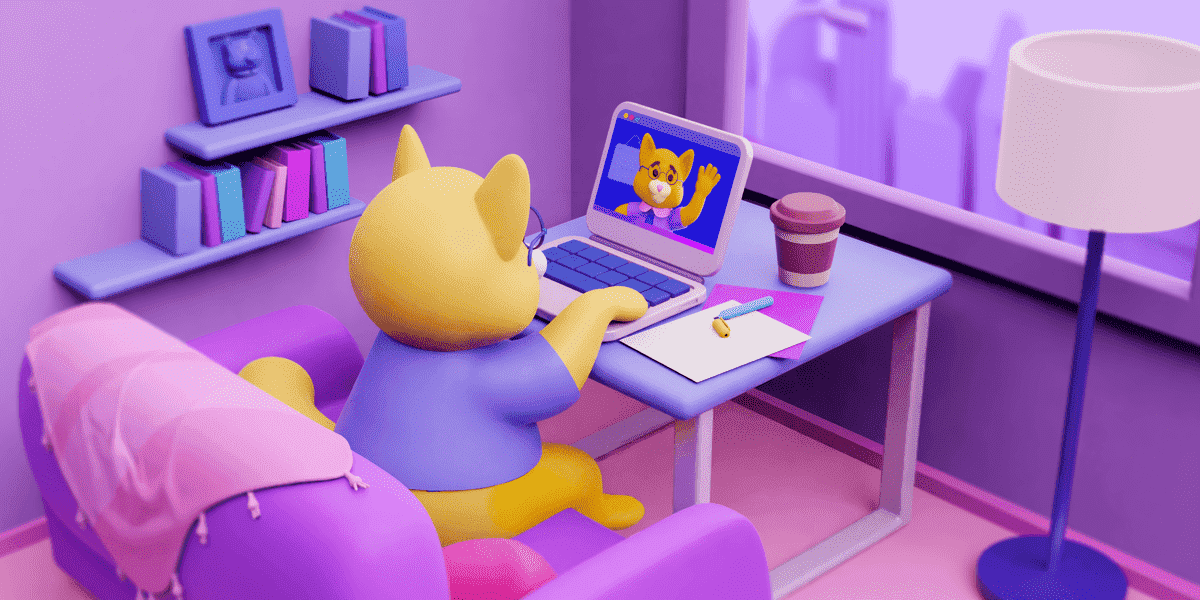
Table of Contents
Best ways to start a conversation at work
If you want to establish a healthy company culture, you need to understand the difference between positive and negative communication in the workplace.
According to a workplace culture expert, Jessica Kriegel, the way people feel while they’re at work is at the core of that challenge. She says:

“You want people to have good experiences at work and appreciate where they are at. That drives belief, which drives action, which drives results.”
In other words, having positive interactions can ultimately make people more engaged at work, which will make them better at their jobs.
From a micro perspective, knowing how to engage in more casual workplace conversations will help you:
- Gain respect and influence in your field of work,
- Establish rapport and strengthen professional relationships, and even
- Make some personal connections and friendships along the way.
And it all starts with learning how to initiate conversations.
So, without further ado, let’s talk about the best ways to accomplish that!
Method #1: Introduce yourself
If you’ve never actually met the person you want to engage in conversation, the best way to start talking to them is to simply introduce yourself.
Corporate motivational speaker and author, Debra Fine, shares several tips for making professional introductions in her book The Fine Art of Small Talk.
The small talk expert stresses the importance of committing your interlocutors’ names to memory after giving your own name.
If you mishear or forget the name of the person you’re talking to, Fine recommends a swift confession along the following lines:
“Sorry, I’m not sure I got your name.”
“Excuse me, I’m afraid I’ve forgotten your name. Could you please remind me?”
Aside from that, Fine also emphasizes the importance of using the name we were given in its original form, advising her readers to “nix the nicknames.” To that end, she writes:
“If someone has a difficult name, make the effort to learn it — do not shorten it to a nickname without permission!”
In a world of increasingly diverse and inclusive workplaces, this tip is key.
Method #2: Comment on your surroundings
Commenting on one’s surroundings or general circumstances is a fairly safe place to start a conversation.
That’s why the weather and current events are among the most used topics to talk about with coworkers.
Of course, in professional settings, the surroundings can also include any changes we spot around the office or the decorations at the annual team building event.
Then again, these kinds of topics can seem a bit uninspired to those who are seeking a deeper connection. That’s why this method is mostly used by people who are just starting to learn about their coworkers.
For them, making casual comments about what they had for lunch or the fact that someone left doughnuts in the break room can be a good way to set everyone at ease before segueing into more substantial topics.
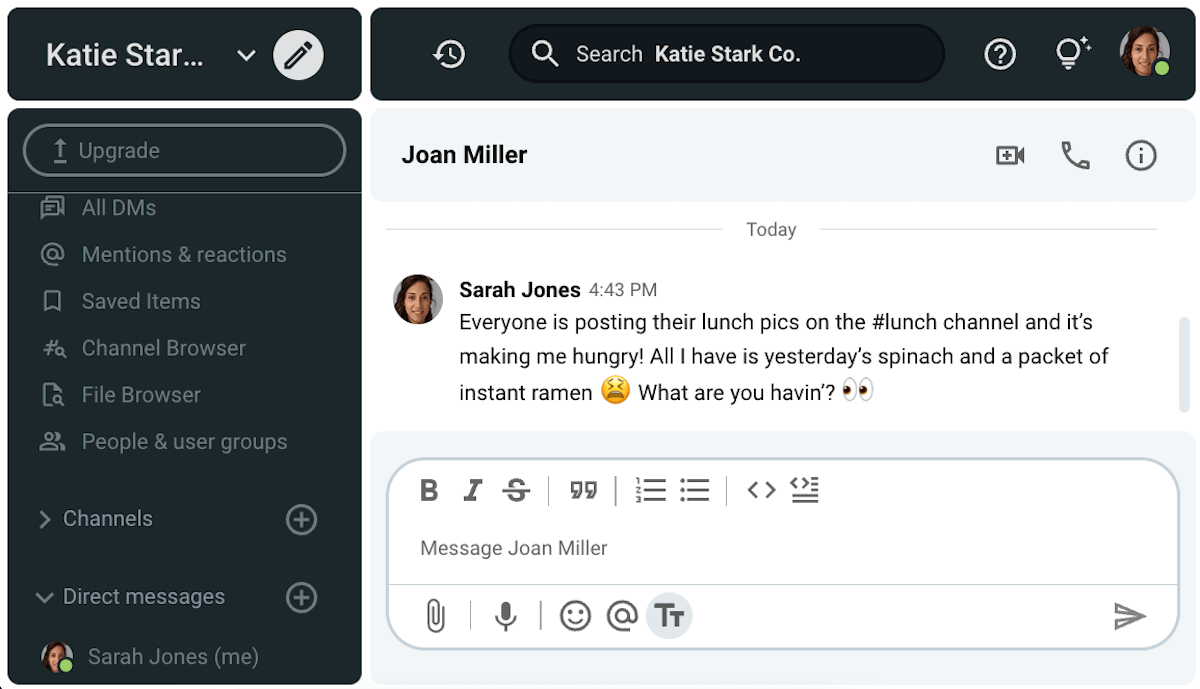
Method #3: Discuss pop culture or industry news
Once you learn a thing or two about your coworkers, you can start testing the waters with some more interesting small talk topics for work.
If you’ve already discovered that the person you want to approach is interested in a particular genre of movies, you can use an opener that reflects that.
Otherwise, you could always mention an industry trend and start a conversation that way.
This method is also the perfect place for us to incorporate more of Debra Fine’s advice.
According to the small talk expert, the best workplace conversation starters are a combination of a statement and a response prompt.
So, instead of just saying “Apparently, experiential marketing is making a comeback,” you could add:
“Have you ever tried to incorporate something like that into one of your marketing campaigns?”
Of course, this tip should work just as well — if not better — with more casual topics of conversation.
Method #4: Ask for help or offer to help
According to a career coach, therapist, and member of the Forbes Coaches Council, Jessica Sweet:

“One of the best ways to start a conversation at work with someone you don’t know is to ask a simple question or to ask [for] a favor.
The ‘Ben Franklin Effect’ is the idea that people like you more when they do you a small favor.
So, start a conversation by thinking of a small ask, and then dive into [other topics].”
However, asking for help in the workplace can have adverse effects. As workplace culture expert, Jessica Kriegel, says:

“If you’re going to do that, you need to contextualize how much work the other person has on their plate, why you need it, and the timeline. You need to almost pre-apologize for asking. Otherwise, [they might see you] as a person that off-loads their responsibilities onto others (if it happens a lot — not once or twice). You need to approach the other person with context, essentially.”
The key to using this method to start up a conversation with someone you work with is to make sure what you’re asking for isn’t too time-consuming.
After all, the ask itself is only the beginning of the conversation, so even something innocuous will do the trick. To illustrate that point, let’s look at the example below.
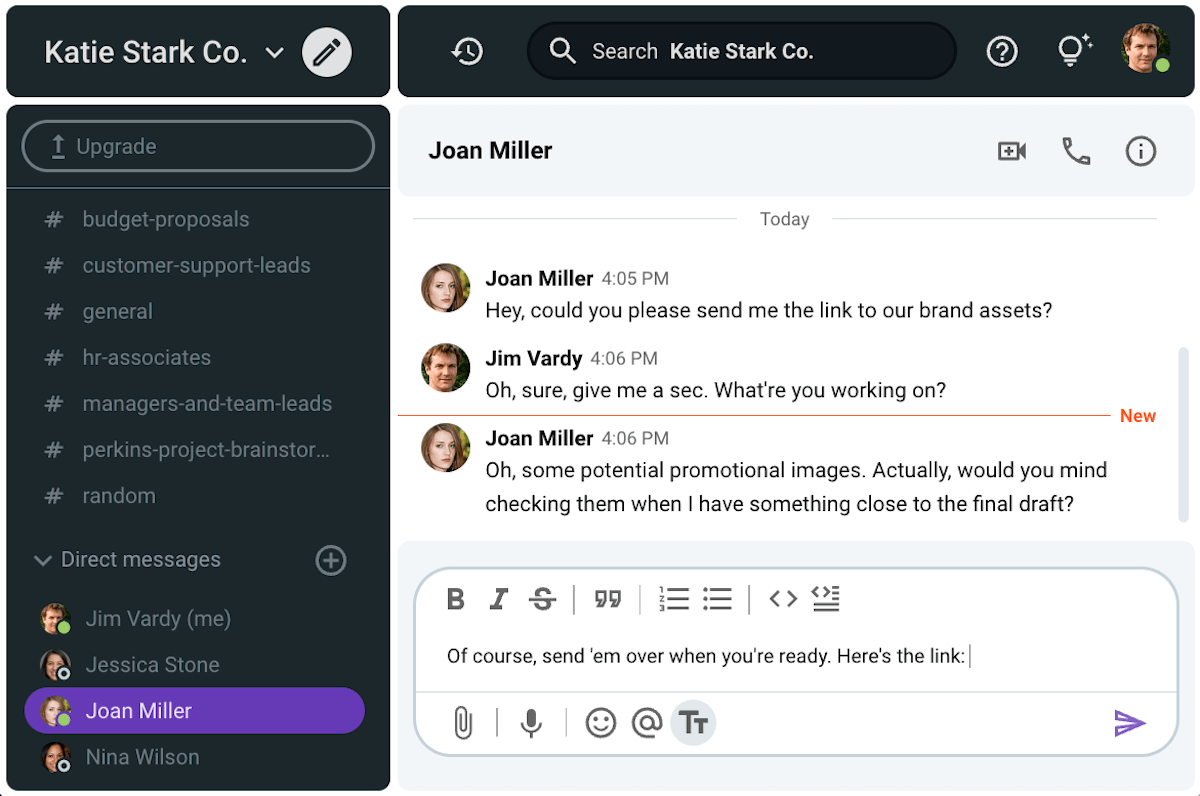
💡 Pumble Pro Tip
Not sure how to go about asking for a favor at work? Check out this guide:
Method #5: Ask questions
If you’re not satisfied with superficial conversation starters, you can dive deeper by asking a question.
In her book, Debra Fine suggests using open-ended questions and statements such as:
“Why?”
“How did you…?”
“Could you describe…?”
“I’d love to learn more about…”
“What was that like for you?”
“What brought you to…?”
Of course, you wouldn’t want to sound like you’re interrogating your interlocutors.
With that in mind, you should also offer some information about yourself before asking the other person any questions.
Even then, you should take care to stay in the realm of appropriate topics of conversation in the workplace. And if you’re not too sure which ones would fit the bill, executive public speaking coach, bestselling author, and international speaker, Karen Donaldson, has the answer.

“Appropriate topics [of discussion would be] the company, the work that you do there, and accomplishments. On a non-invasive personal level, you can discuss leisure time activities, hobbies, vacations, upcoming holidays, and weekend plans. […] When you go into the territory of asking non-invasive personal questions, people start to build relationships with one another.”
However, the confidence coach also noted that sometimes, the people we approach with a conversation starter may be reluctant to share. So, that’s something we should expect and accept.
💡 Pumble Pro Tip
If you haven’t mastered the art of asking the right questions in the workplace, this guide should come in handy:
Method #6: Give a compliment
Most people believe that being complementary is one of the safest ways to start a conversation in the workplace.
However, the wider context and the exact wording you use can make or break your chances of having a pleasant and, more importantly, respectful interaction.
With that in mind, there’s only one steadfast rule you should follow when complimenting someone you work with — or, really, anyone you don’t know that well.
Namely, you should avoid commenting on body parts, at least anything that isn’t a conscious choice. That exception should still allow you to tell a coworker their new hair color looks nice.
But, to be safe, you should try to restrict yourself to praising professional achievements rather than physical attributes.
As career and business coach, Corbet Fawcett, told us:

“Be cautious of inappropriate comments and microaggressions. What seems like an innocent compliment may have negative implications. When in doubt, keep it professional. Focus on the work, not the person.”
Jessica Sweet went on to add:

“Compliment their work, the quality of their questions or observations, or their work ethic. You want to keep it professional, and noticing what they do, how they do it, and the impact it had can go a long way in making someone feel seen and appreciated.”
On the subject of providing employee recognition, Jessica Kriegel also stressed the importance of being specific when giving compliments. She says:

“Too many managers rush past an employee on the way to another meeting and say ‘Good job, Tom!’ Tom has no idea what exactly he did a good job on. Tom is happy but confused. Be more specific.”
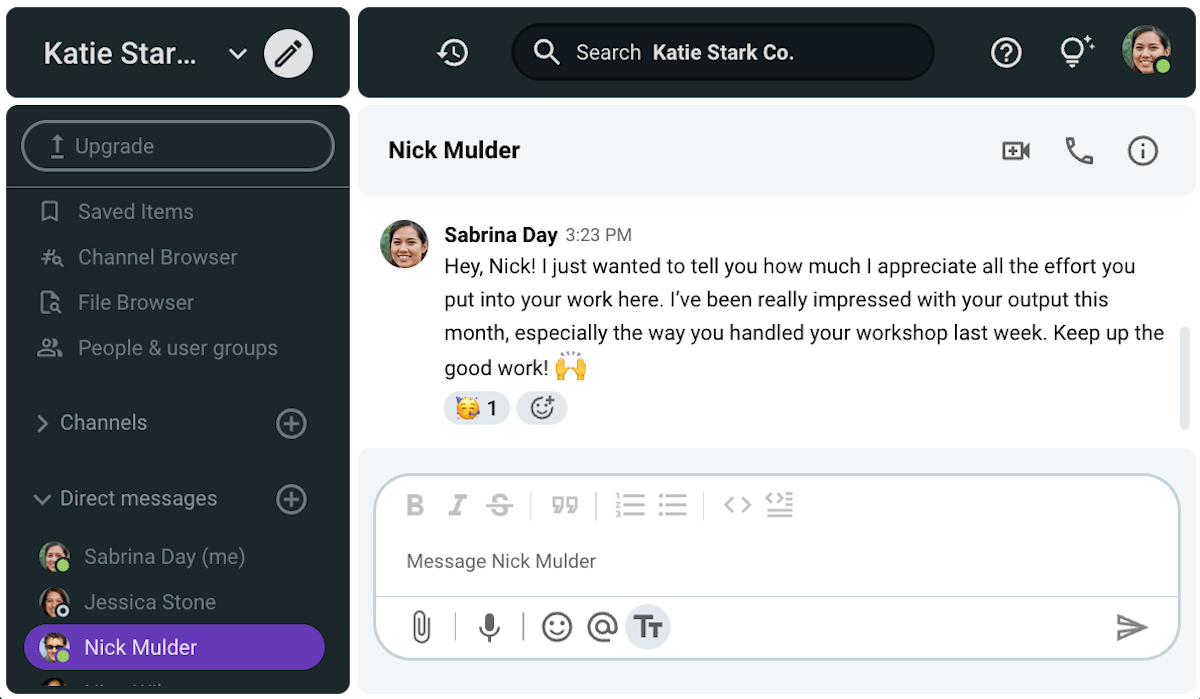
Method #7: Tell a joke
At this point, you may have noticed a progression on our list of methods you can use to start a conversation at work.
Essentially, the workplace conversation starters in the first half of our list would allow you to strike up a conversation with any passing acquaintance. Meanwhile, the methods we have introduced in the latter half would work better on coworkers you were more familiar with.
So, what does that tell us about using humorous conversation starters at work?
Basically, you should limit their use to people you already know fairly well.
After all, even professional comedians can never be sure about the types of jokes that will “land” well with their audiences. The only way you can be reasonably certain that your joke won’t offend anyone is if you knew your interlocutors’ preferences in that regard.
Remember: telling the wrong joke at the wrong time can have disastrous professional consequences.
According to a study that looked at the way humor can increase or decrease status, even though “inappropriate joke tellers” are perceived as more confident, that positive impression doesn’t extend to people’s opinions of their professional competency.
In fact, people tend to see those who use inappropriate humor in the workplace as “less competent and lower status” (even when the joke was actually funny).
As one author of the study concluded:
“These results demonstrate the risk inherent in humor: Telling a bad joke is all right, but telling an inappropriate bad joke is quite costly.”
With that in mind, we suggest that you familiarize yourself with the appropriate topics of conversation in the workplace before attempting to deliver any witticisms.
💡 Pumble Pro Tip
If you overhear an inappropriate joke at work, this guide might help you deal with it:
Method #8: Send them a direct message
In bygone days, most people would have felt that using conversation starters at work was limited to the short breaks they had away from their desks.
Luckily, that is no longer the case, as communication can be achieved anywhere, even from the comfort of one’s cubicle. The use of team communication tools has certainly made the recent necessity of remote work more tolerable.
After all, as Karen Donaldson notes:

“One of the challenges when working on a remote team is that people feel like they don’t know each other and there is less comradery.”
Of course, with this kind of workplace communication, knowing how to balance work-related communication and chit-chat is key.
In an office environment, you would be able to see which of your coworkers are interested in small talk by examining the nonverbal cues they send.
However, when the only thing you see is your coworkers’ virtual presence, you have to rely on:
- Their usual personality (keeping in mind that everyone can have good and bad days),
- Their messaging availability status (as seen in the image below), or even
- What their workload looks like (which you can check on the time or task management software your company uses).
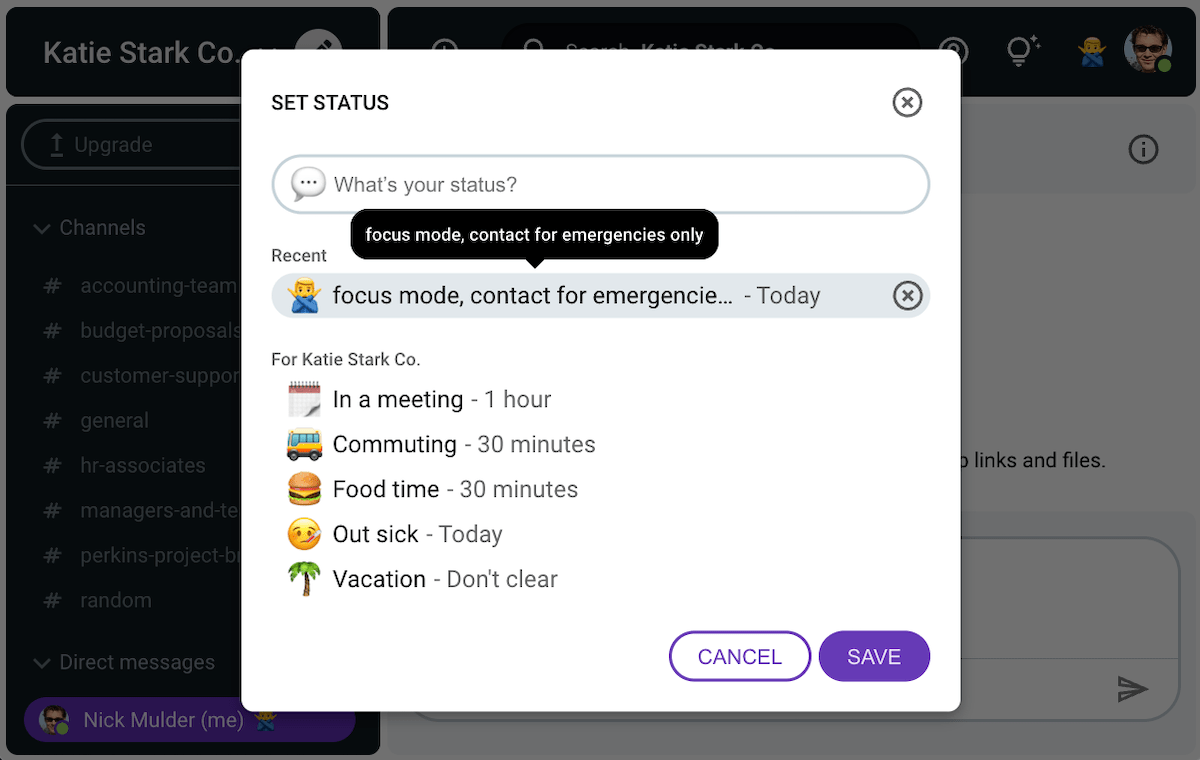
💡 Pumble Pro Tip
Texting people during their lunch break can be a faux pas, especially if you’re not friends on a personal level. To learn more professional messaging etiquette, check out this article:
Bonus tip: Avoid controversial topics
The success rate of conversation starters that rely on questions, compliments, and jokes usually depends on their delivery, wording, and central topic.
Since that last condition is particularly important, we asked experts to share what they believe are the topics everyone should steer clear of in the workplace.
Karen Donaldson put it simply:

“Avoid conversations about race, religion, and politics — especially if it is not integral to your job.”
And, Jessica Sweet agreed, adding that certain topics can spark difficult conversations:

“Avoid other people’s appearance as well as controversial topics such as religion and politics. These things tend to lead to difficult conversations that need to be handled carefully and can go bad easily. If they do go bad, you still need to work with the other person. It’s best to avoid these altogether.”
Lastly, workplace culture expert, Jessica Kriegel, pitched in with some broader context surrounding the matter of inappropriate topics for the workplace.

“The ‘what’s appropriate’ discussion has shifted a lot as workplaces have become more progressive over the last 5–10 years.
Some companies, famously 37 Signals (Basecamp), even tried to ban political discussion at work. It backfired and people quit, although it’s a really hard thing to even try to do logistically because anything could fall under the umbrella of ‘political’ at some level.
My main rule would be to keep most of the work conversations focused on either (a) immediate work or (b) a person’s life outside work, i.e. family or weekend plans or something, and not lean into the macropolitical scene. But, different workplace relationships have different contexts.”
In other words, you should understand that small talk in the workplace is highly dependent on many factors, including your level of familiarity with your interlocutors.
115 Best work conversation starters for any occasion
Having shared experts’ opinions about the best conversation starters to use at work, it’s time to finally see their tips in action.
Some of the examples we’re about to list are from Debra Fine’s The Fine Art of Small Talk, while others are sourced from all over the Internet (as well as the collective experience of anyone who’s ever had a casual conversation at work).
Now, we’ve decided to break up our compilation into the following categories:
- Basic and neutral conversation starters for work,
- Work-related conversation starters,
- Career-focused conversation starters,
- Observational conversation starters for work meetings, events, or conferences,
- Entertaining team conversation starters inspired by pop culture,
- Quirky and humorous conversation starters for coworkers, and
- Seasonal or holiday-related conversation starters for work.
Naturally, not all of our examples will apply to your current situation. Still, you should be able to find plenty of phrases you can use to start a chat or an in-person conversation with someone you know professionally.
With that being said, let’s get into our list!
Category #1: Basic and neutral conversation starters for work
The first category of workplace conversation starters we have compiled consists of the basic statements and inquiries you might use to start a casual conversation at work.
Most of them are related to your interlocutors’ day, their lunch plans, and the superficial aspects of their life outside of work.
Without further ado, let’s see some examples of conversation starters for coworkers, employees, and managers alike!
- “Hey, [name]! How’re you doing?”
- “How’s your day going?”
- “What are your plans for this weekend?”
- “Did you do anything fun last weekend?”
- “How’re the kids?”
- “How’s your partner/[insert partner’s name to personalize prompt]?”
- “Do you have any pets?”
- “How’s your dog doing? Is she free of the cone of shame yet?”
- “What do you do in your spare time?”
- “I’m headed to a painting class after work. How about you? Do you have any hobbies?”
- “What are the best lunch spots around here?”
- “What are you thinking about having for lunch?”
- “Should I get pasta or pizza? I haven’t tried either of those here.”
- “I’m off to get coffee, would you like to join me?”
- “Hey, want to go out and do some people-watching during our break?”
- “The weather is so nice today, I wish we could have a picnic right now.”
- “You won’t believe what just happened to me on the way to work…”
- “Wow, my brother loves quirky socks, too! Where’d you get those?”
- “That’s a really nice bag! Can you fit your laptop in there?”
- “My phone has been so buggy lately, I’m thinking about getting a new one. Are you happy with yours?”
Here’s how you can incorporate these kinds of prompts into your workplace conversations.
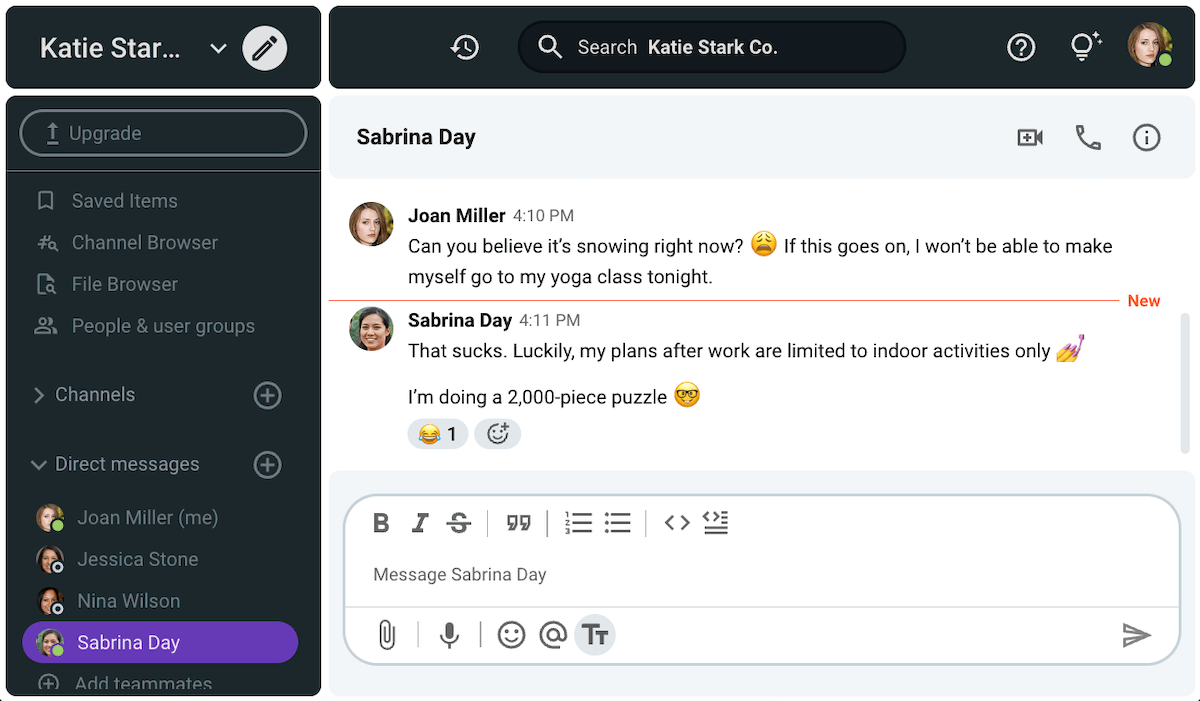
Category #2: Work-related conversation starters
If you’re wondering what to talk about with coworkers you don’t know that well, work-related topics are your best bet.
Here’s how you might get those conversations started.
- “How’s that report coming along?”
- “How are you managing your workload?”
- “Do you need any help with that task?”
- “What’s your passion project right now?”
- “Are you working on anything exciting lately?”
- “What was the highlight of your week/day?”
- “I’m a bit nervous about the task I was assigned. Have you ever done something like it before?”
- “What did you think about what we discussed during that meeting?”
- “Do you usually prefer virtual meetings or in-person ones?”
- “I really liked your presentation about [topic]!”
- “That was such a great idea — how did you come up with it?”
- “Did you read any books when you were preparing to give your presentation?”
- “Could you recommend some resources for improving public speaking skills?”
- “What do you think will be the next trend to take the industry by storm?”
- “Have you heard about the latest industry trend making the rounds?”
You can even see how this prompt might play out in real life in the simulated conversation shown below.
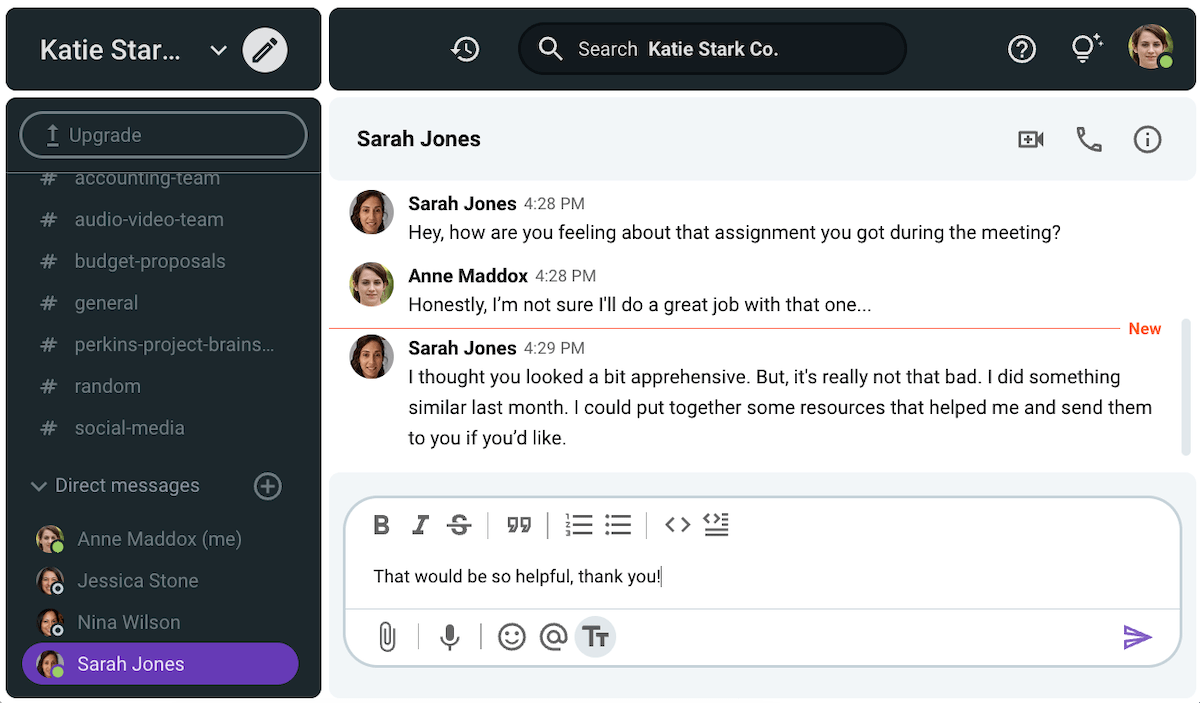
Category #3: More career-focused conversation starters
Now, this category of work conversation starters consists of prompts you can use to gain a deeper understanding of your coworkers’ career trajectories.
So, rather than inquiring about your interlocutors’ current workloads, these questions would be more suitable for interviewing mentors, managers, or senior colleagues.
If you find those kinds of interactions invaluable, here are the best ways to get the conversation started.
- “So, how long have you been with the company?”
- “Can you share any insider tips about this industry/working here [with me]?”
- “What would you say has been your most important work experience?”
- “What are the best and worst jobs you’ve ever had?”
- “How did you become interested in your field of work?”
- “What’s your favorite thing about your job?”
- “How would you advise your junior colleagues?”
- “Do you have any professional regrets you wish you could go back and change?”
- “Is this your dream job? Do you have something you’d rather be doing?”
- “When I was a kid, I wanted to be a math teacher. Can you imagine? What did you want to be when you were young?”
The latter examples in this category demonstrate how these questions can be delivered in a more personable way.
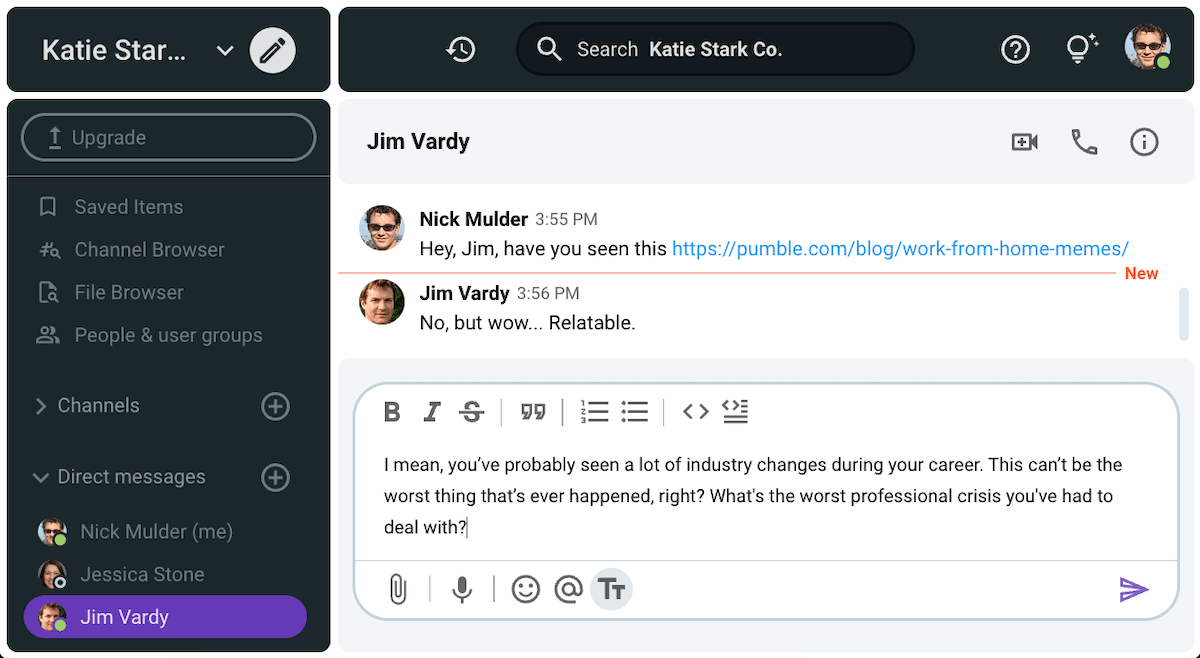
💡 Pumble Pro Tip
Usually, the people who educate junior employees about the current state and future trajectory of the industry are older employees. With that in mind, improving workplace communication across generations could be beneficial. This article is sure to help:
Category #4: Observational conversation starters for work meetings, events, or conferences
Some of the workplace conversation starters we have already listed have observational elements.
However, in this category, we’re going to focus on casual remarks you can make at work events or conferences.
- “Have you ever been to a work event before? Did you have them at your previous job?”
- “Isn’t it strange seeing everyone in person like this? I’ve gotten so used to seeing y’all through a screen!”
- “They really went all out with the decorations, didn’t they? Did you see the flower arrangements?”
- “What an amazing venue! I hope they keep booking it.”
- “Have you tried any of these cocktails/appetizers?”
- “All the food looks so good… I’m not sure what to pick. What are you thinking of getting?”
- “I’d love to try this cake but I don’t think I could eat the whole piece. Would you split it with me?”
- “Have you heard the news? Apparently, the company is looking to bring in more people to the PR department.”
- “Did you bring a plus one?/Who have you brought with you today?”
- “I hear the DJ is taking requests. Should we go suggest a song?”
- “Wow, it’s like a dance battle out there! Who do you think is winning right now?”
- “Can you believe Jim is retiring? I remember one time he [tell anecdote].”
- “What did you think about Darla’s speech?”
- “Which workshop are you most excited about?”
- “Would you ever want to hold a workshop here? What would it be about?”
Of course, many of these prompts can be used outside of in-person get-togethers, as evidenced by workplace conversation examples like the one below.
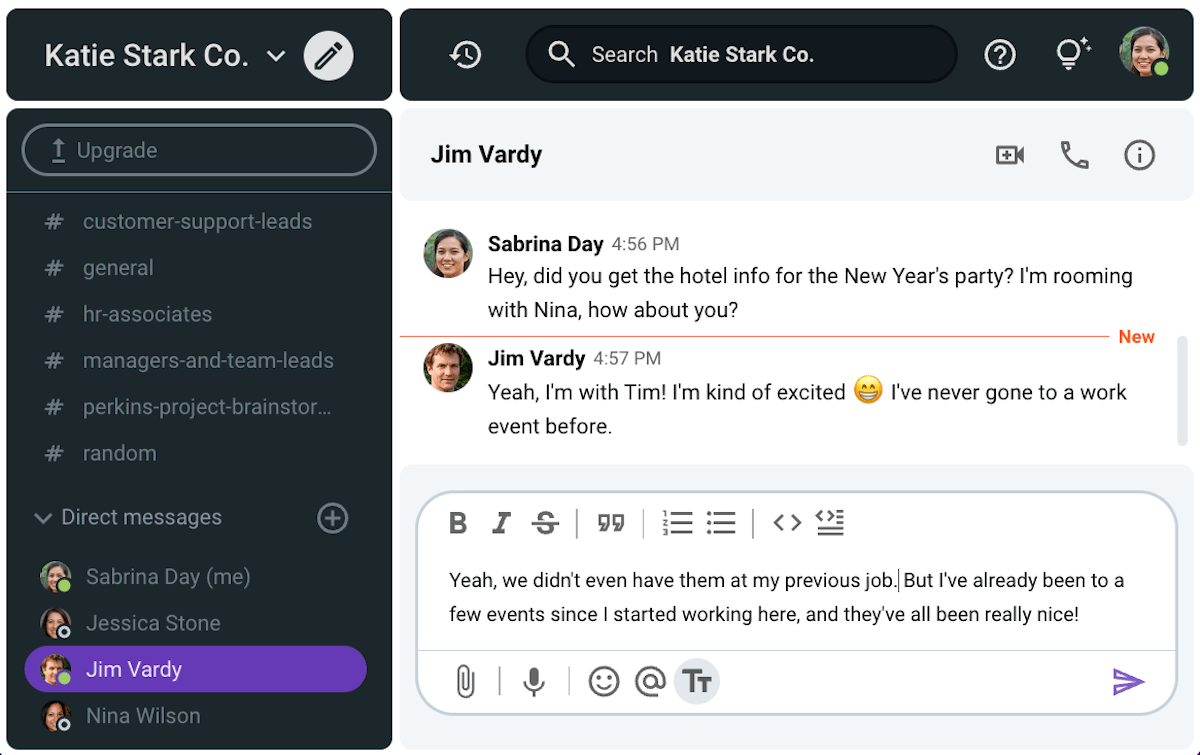
Category #5: Entertaining team conversation starters inspired by pop culture
If you already have an established rapport with your interlocutors, feel free to broach more entertaining topics.
- “What’s your favorite movie?”
- “Are you watching anything good on TV?”
- “Which streaming services are you subscribed to?”
- “This video is cracking me up, check it out!”
- “Have you seen that TV show/basketball game/news segment?”
- “How do you feel about podcasts? Do you listen to any?”
- “Would you say that you have any niche interests?”
- “Have you played this card/board game?”
- “Who’s your favorite author/musician/celebrity?”
- “What kind of music do you listen to? What’s on your playlist right now?”
- “Do you prefer listening to live music or listening to albums at home?”
- “What was the first concert you went to?”
- “When you realize you’re watching a bad show, do you stop or do you push through?”
- “I just finished reading this book. It may be my new favorite. Do you have a favorite book?”
- “You know what? The more interviews I see with that actor, the more convinced I am that he’s an alien. Which celebrity do you think is most likely to be an alien?”
- “Did you read about that actress’s fitness routine? Wild. When does she sleep?”
- “They’re giving that author a lifetime award. What would you want to be remembered for?”
- “Have you seen how that celebrity reacted when they were on that prank show? How do you think you’d react if you were pranked like that?”
- “Yikes, they’re making a gritty reboot of another animated classic. Place your bets, which one do you think it is?”
- “If you could make everyone you know listen to a song/watch one movie/read one book, which one would you choose and why?”
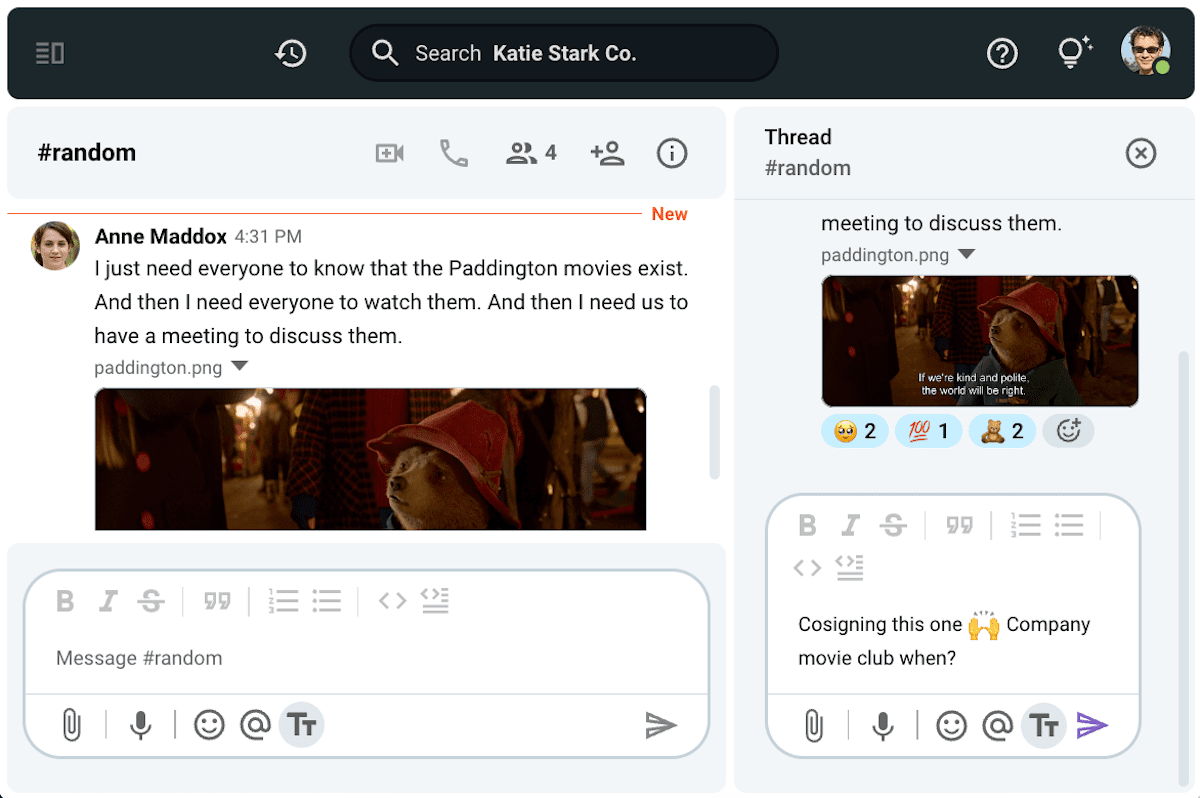
Category #6: Quirky and humorous conversation starters for coworkers
Once you get comfortable with the people you work with, you can even reach for the weird team conversation starters.
Since these require more abstract answers, they can give you a better understanding of the inner workings of your coworkers’ minds.
Alternatively, they can just be a great way to entertain your audience and recharge during your breaks.
- “Do you have any secret talents?”
- “If you were a ghost, who would you haunt?”
- “Which superpower would you like to have?”
- “If you could max out a skill with a cheat in real life, which one would you choose?”
- “If you could get a hypnotist to remove one of your flaws, what would it be and why?”
- “Do you have any items you’ve saved from childhood?”
- “What’s the most fun you’ve ever had?”
- “What would you title this chapter of your life?”
- “What’s the silliest thing you’ve ever seen an animal do?”
- “Do you think you could survive a zombie apocalypse? What would you do if it broke out while we were at the office?”
- “Let’s say everyone in the office is cast in a heist movie. Who has which role?”
- “If your life was a TV show, what genre would it be? What would be the opening credits song?”
- “What would you do if you had all the money in the world and all your needs were taken care of?”
- “I just found out that Australia was at war with emus in the 1930s, and the emus won. Isn’t that crazy?”
- “What mindblowing facts have you learned recently?”
💡 Pumble Pro Tip
If you want to have casual conversations on your company’s internal messaging software, make sure you keep them in dedicated channels. Learn more about that particular feature here:
Category #7: Seasonal or holiday-related conversation starters for work
Throughout the year, there are many significant events that come with the changing of the seasons.
The following work conversation starters should cover everything from summer vacations to holiday greetings.
- “How do you feel about New Year’s resolutions?”
- “What were your resolutions last year? Did you achieve your goals?”
- “Do you have any plans for Valentine’s Day?”
- “My friends are going to an Irish pub for St. Patrick’s Day. Do you celebrate?”
- “Are you going to travel this summer? What’s the coolest place you’ve ever been to?”
- “Do you have a place you’ve visited that you hope you never go back to?”
- “What’s the best vacation you’ve ever taken?”
- “How was your vacation?”
- “What are you doing for Thanksgiving?”
- “Do you like having family gatherings?”
- “What was the best Halloween costume you’ve ever put together?”
- “Are you looking forward to the holiday season? What’s your favorite holiday?”
- “Are you going back to your hometown for the holidays? What’s it like there?”
- “I love rainy days! What’s your favorite thing to do in this kind of weather?”
- “I’m trying to find this toy my kid requested for Christmas but it looks like it’s sold out everywhere! Where do you shop for your kids’ presents?”
- “Are you done with your holiday shopping yet?”
- “What a year! What was the highlight for you?”
- “Do you do any winter sports? Have you tried skiing or snowboarding?”
- “Do you have any family traditions you’ve decided to bring into your household since you’ve had kids?”
- “I love the smell of pine, it really makes me get into the Christmas spirit. Do you have any scents that bring back memories?”
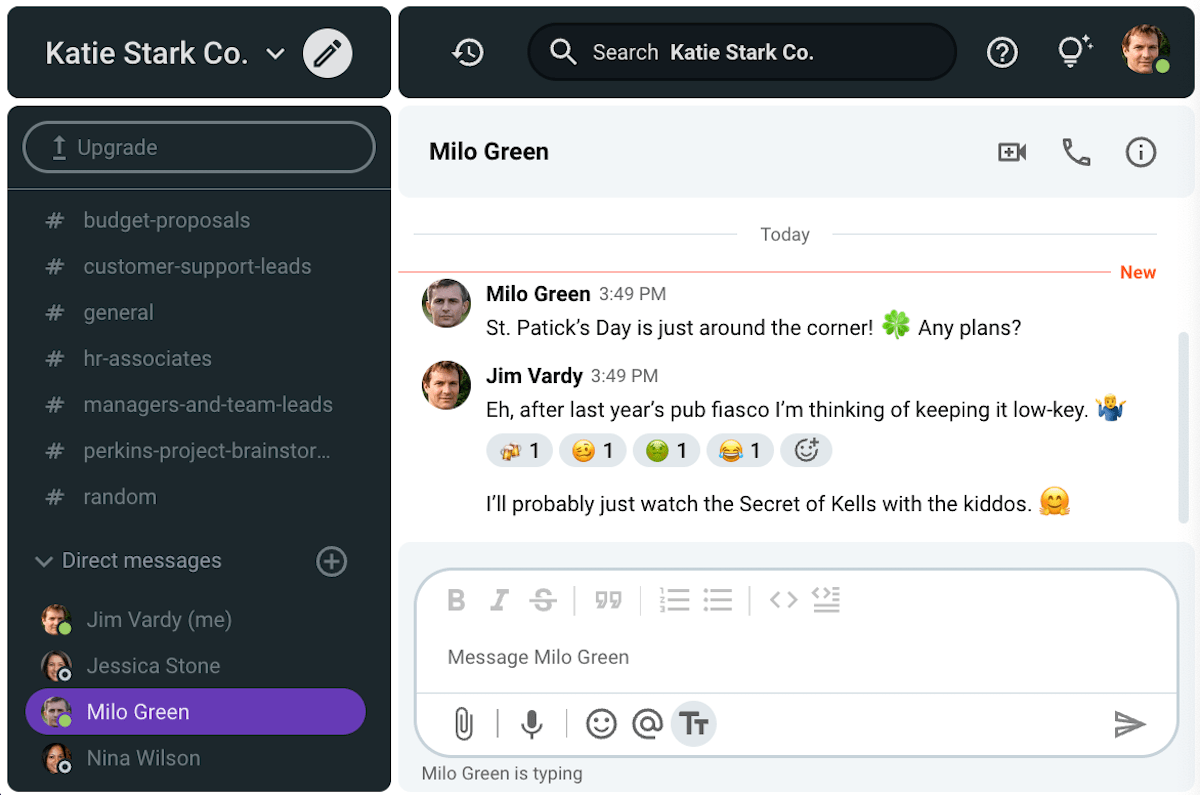
3 Traits that make workplace conversations easy
Before we wrap up, we’d like to point out that the successful delivery of these work conversation starters largely depends on the speaker’s social aptitude.
Luckily, those looking to become effective communicators in the workplace (and beyond) will be pleased to learn that that particular skill can be honed.
In fact, to break it down further, there are 3 traits you can work on if you want to learn how to initiate a conversation successfully.
Trait #1: Attentiveness
Arguably, the most important trait you can bring to a workplace conversation is attentiveness.
For(bes) The Culture Council Member, creative communication, and DE+I expert, Anna Taylor, mentions the importance of developing active listening as a skill:

“The best way to show you’re interested in what a coworker has to say is to practice active listening. Active listening is a communication skill that involves going beyond simply hearing another person’s words but also seeking to understand the meaning and engaging beyond short responses.”
Meanwhile, Jessica Sweet turned our attention to the issue of body language, saying:

“It’s surprising how many people let their minds (and eyes) wander while someone else is speaking. Show that you’re interested by listening, keeping your eye contact appropriately on the other person, and asking relevant questions.”
Essentially, being fully engaged in a conversation is a great way to show respect and genuine interest in your conversational partner(s).
On occasion, the practice of attentive listening may also require us to exercise other skills, such as emotional control and empathy.
Trait #2: Positivity
Some people might suggest that a good way to bond with the people you work with is by sharing common complaints.
To that end, many people will take the opportunity to mention the broken coffee machine in the break room or disparage an annoying coworker as a means of starting a conversation.
However, we recommend that you keep such negative statements to a minimum, particularly when initiating workplace conversations.
After all, you wouldn’t want to become known as the company’s resident Debbie Downer.
Take it from communications consultant, Jana Lynne Sanchez:

“Be authentic. If you don’t like something, don’t mention it. There is something likable about most people. Find it and mention it.”
💡 Pumble Pro Tip
If you are dealing with difficult people at work, practicing your communication skills with them will serve you much better than badmouthing them in front of other coworkers. This article should help you find a way to talk to all manner of challenging colleagues:
Trait #3: Confidence
Becoming more confident can be a huge help when it comes to initiating conversations at the workplace.
However, some people mistakenly equate confidence with arrogance — which happens to be one of the worst conversational sins, according to author Debra Fine.
In fact, many of the conversational faux pas Fine mentions in the Crimes and Misdemeanors chapter of The Fine Art of Small Talk could instead be seen as coming from a lack of confidence.
A person who is unsure of themselves might:
- Interrogate their interlocutors,
- Brag about their accomplishments too much,
- Interrupt or try to one-up others in conversation, and
- Monopolize conversations under the pretense of keeping the ball rolling.
Conversely, true confidence means seeing the worth of your accomplishments as well as understanding your shortcomings — and being willing to work on them.
From that perspective, we can imagine that a truly confident person would be able to:
- Avoid oversharing,
- Laugh at themselves rather than mocking others,
- Acknowledge other people’s efforts and achievements,
- Keep a friendly demeanor through expressions and body language,
- Ask meaningful questions and show interest in the answers, and ultimately
- Initiate workplace conversations more easily.
On top of that, confident people would be able to embody their convictions through nonverbal communication.
💡 Pumble Pro Tip
If you want to make sure you’re sending the right nonverbal messages when communicating with coworkers, this guide might help:
Final Thoughts: Be genuine and authentic above all
Establishing genuine connections through banter can make even the most tedious days at work much more interesting.
Still, needing help in that regard is only natural, especially after several years away from the office.
Hopefully, this guide provided plenty of inspiration for your next water cooler conversation with coworkers.
To sum it all up, we’re going to leave you with a quote from Karen Donaldson. She says:

“First of all, only start a conversation if you’re willing to be an attentive listener. Then, keep things simple. Start with something relatable to the both of you (the company, the job). When you want to build relationships with your co-workers, you want to go beyond work while respecting people’s privacy.”
Pumble is the best place for starting a conversation in a remote work setting
Many of us work in a hybrid or remote environment. Hence, we largely depend on the efficiency of our team messaging apps.
When it comes to the efficiency of team communication apps, Pumble is definitely among the best ones.
First, thanks to Pumble you can easily start conversations with your teammates by sending direct messages, or you can post in various dedicated channels when you want to engage a group of people.
Moreover, everything you send will be saved forever, due to Pumble’s unlimited message history.
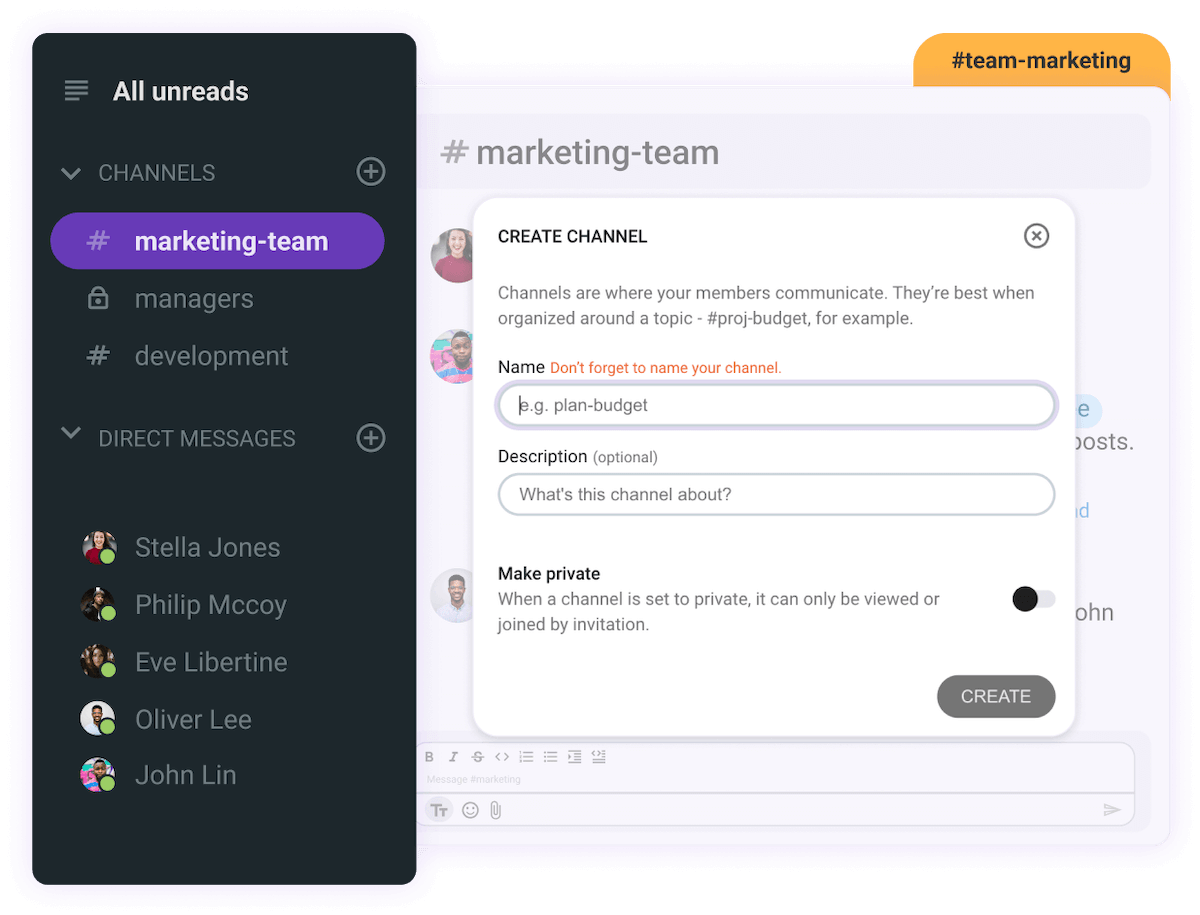
Also, thanks to threads in Pumble, your side discussions don’t have to clog your communication channels.
Secondly, in Pumble, you are not limited to starting conversations with colleagues from your organization solely. You can invite guests and give them roles and permissions to make them feel at home at your organization’s workplace.
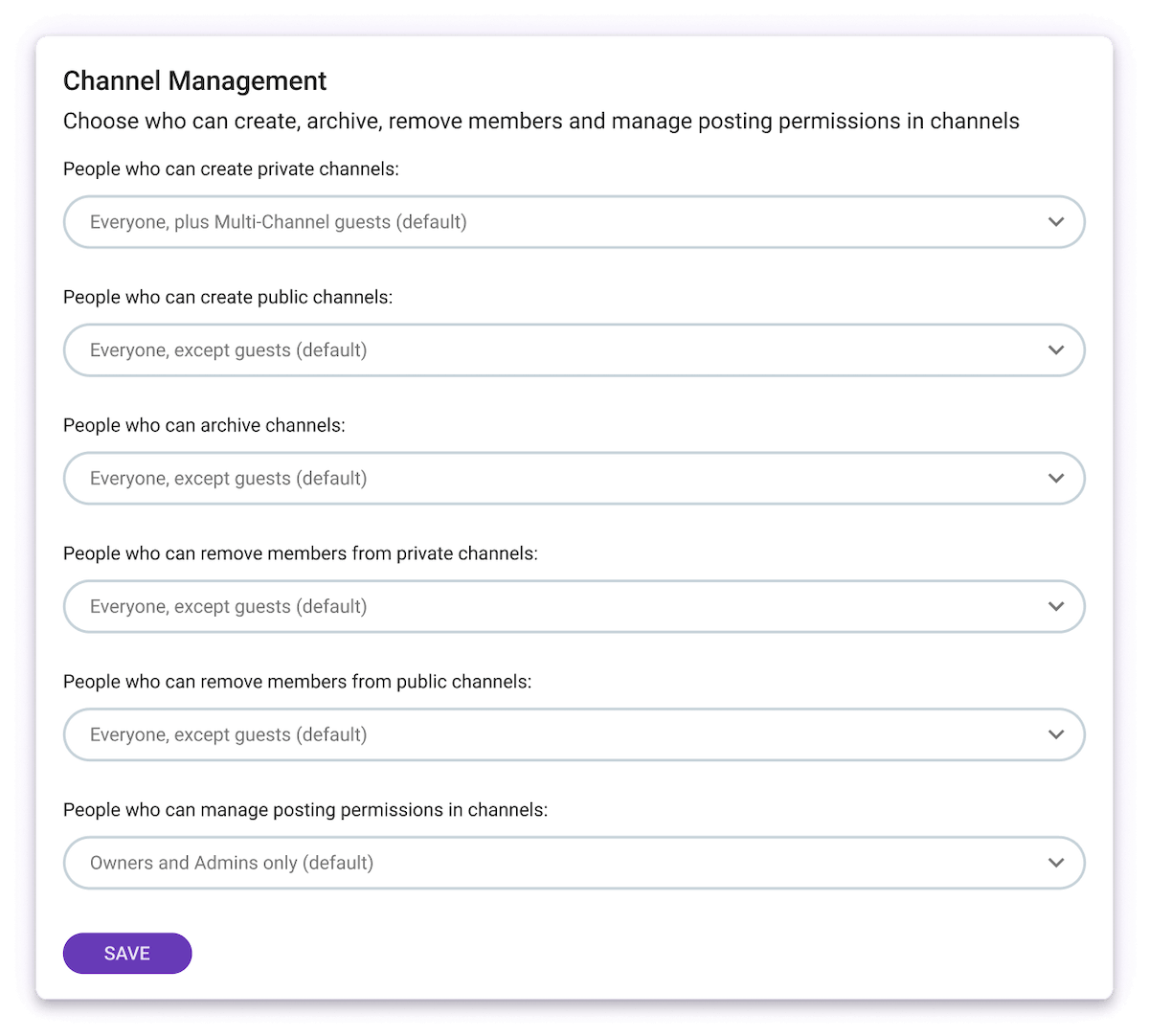
Finally, you can always test your conversation starters in audio or video format thanks to voice calls and video conferencing functionalities in Pumble.





